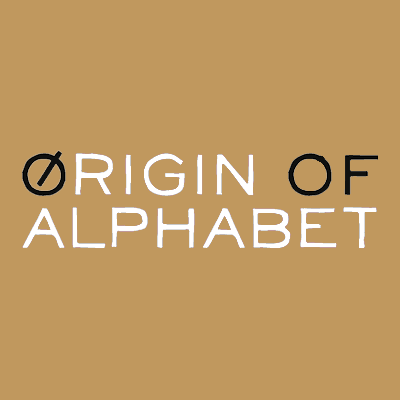Wang ba is a cuckold which is a tortoise
Mandarin I Berkeley Extension – Class 5 – Oct. 4, 2011
425 Market Street
San Francisco, CA
Professor: Virginia Mau
Notes taken and commentary (marked by“Note:”) by Jennifer Ball (because of the typeface which I must use to render the Chinese characters correctly, extra spaces are occasionally seen before and after apostrophes and quotes).
Next class: Homework: Workbook Pages 6-7, #1-4, also page 10, #4-5 (for 5, write characters not pinyin); No quiz
Make-up quiz for those who want to take it: in 2 weeks on 10/18/11. No class 11/22/11
More class notes to come:
Wangba:
tortoise, cuckold
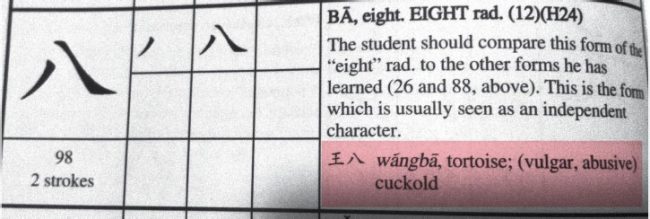
From Mandarin Chinese Profanity in Wikipedia (quote):
Illegitimacy
Many insults imply that the interlocutor’s mother or even grandmother was promiscuous. The turtle is emblematic of the penis and also of promiscuous intercourse. Eggs are the progeny of turtles and other lower animals, so the word dàn (蛋) is a metonym for offspring.
* wángbā (王八) / wàngbā (忘八) =cuckold; this was an insult as early as the Song dynasty [960 and 1279 A.D.]
* wángbādàn (王八蛋, informal simplified: 王八旦) / wàngbāgāozi (王八羔子) = bas-tard (lit. “turtle egg” and “turtle kid.”)
* guī sūnzi (simplified Chinese: 龟孙子; traditional Chinese: 龜孫子) / guī érzi (simplified Chinese: 龟儿子; traditional Chinese: 龜兒子) = bastard (lit. “turtle grandson” and “turtle son”)
Turtles and eggs
The 中文大辭典 Zhōng wén dà cí diǎn (Encyclopedic Dictionary of the Chinese Language)) (something a little like the OED), discusses 王八 (wáng bā) in vol. 6 p. 281.“Wáng bā” is the term that is usually written casually for the slur that means something like “son of a bitch.”
A “wángbādàn 忘/王八蛋” is the offspring of a woman lacking virtue. Another meaning of 王八 is 鼈 biē, fresh-water turtle.[4] Turtle heads reemerging from hiding in the turtle’s shell look like the glans emerging from the foreskin, and turtles lay eggs. So a“wang ba” is a woman who has lost her virtue, and a “wang ba dan” is the progeny of such a woman, a turtle product, but, figuratively, also a penis product.
“Wáng bā 王八” originally got switched over from another “忘八 wàng bā”(one that referred to any very unvirtuous individual) because of a nasty piece of work with the family name Wáng 王 who picked up the nickname 賊王八 zéi Wáng bā (“the thieving Wang Eight”) but for being a dastard, not for being a bastard. The dictionary doesn’t say, but he may have been the eighth Wang among his siblings. Anyway, he became “crookWang eight” and the term stuck and spread just as “Maverick” did in English. There isa pun here because of the earlier expression 忘八 wáng bā used to describe (1) any per-son who forgets/disregards the eight virtues, (2) an un-virtuous woman, i.e., one who sleeps around. The first meaning applied to the dastardly Wang, but the family name got “stuck”to the second, sexual, term. (end quote)
http://en.wikipedia.org/wiki/Mandarin_Chinese_profanity
And more on Breasts (with enlarged type because somehow that seems appropriate):Breasts(quote)
* mīmī (咪咪; literally cat’s purring “meow meow”) isa euphemism for breast.
* da doufu (大豆腐; literally “big bean curd”) slang for large breasts, more prevalent in Guangdong
* mántóu (simplified Chinese: 馒头; traditional Chinese:饅頭; literally “steamed bun”) also refers to a woman’s breasts; as mantou is typical of northern Chinese cuisine this term is used primarily in northern China.
* bō (波, literally “wave” or “undulating”, but sometimes suggested to be derived from “ball” which has a similar pronunciation) = boobs.[3] The typical instance is bōbà (Chinese: 波霸), which refers to a woman with very large breasts.
* fúshòu (福寿; literally “happy long life”)
* nǎinǎi (奶奶) = boobies (My note: literally “milk, milk”)
* zār(咋) (Beijing slang)* gege (Tianjin slang)* bàorǔ (Chinese: 爆乳; literally “busty breasts (literally“explosive breasts””) = big tits, likely reborrowing from Japanese.* fēijīchǎng (simplified Chinese: 飞机场; traditional Chinese: 飛機場; literally “airport”) = flat breasts* háng kōng mǔ jiàn (simplified Chinese: 航空母舰; traditional Chinese: 航空母艦) – literally “aircraft carrier”, refer-ring to a flat chest. Compare with 战舰 (zhàn jiàn), meaning battleship, which refers to larger-sized “chimneys” of the chest. (end quote)
The rest of class:
More answers for “How are you today?”
今天 好 不好?
jin1 tian1 hao3 bu4 hao3
你好不好?
ni3 hao3 bu4 hao3
不错 = not badbu4 cuo4
錯/错 = mistake; error; blunder; fault; cross; uneven; wrong
cuo4 (sounds like “tua”—almost like “tall” with a New York accent)
还可以 = okay, all right
hai2 ke3 yi3
還/还 = also; in addition; more; still; else; still; yet; (not) yet
hai2
可 = can; may; able to; certain(ly); to suit; (particle used for emphasis)
ke3
以 = to use; according to; so as to; in order to; by; with; because; Israel
yi3
早上好 = good morning
zao3 shang4 hao3
早晚好 = good evening
zao3 wan3 hao3
今早怎么样 = how are you this evening? jin1 wan3 zen3 me yang4 (“jing” is pronunciation and “ze”)
很忙
hen3 mang2 = very busy
非 常忙
fei1 chang2 mang2 = extremely busy.
饿 = hungry
e4
累 = tired
lei4
开 心 = open
kai1 xin1 (“ching”)
周末
zhou1 mo4 = week end(zjoe moah)
周末怎么样? = How’s your weekend?
zhou1 mo4 zen3 me yang4
不怎么样 = not much going on
bu ze3me yang4
你是谁? = what’s your name?
ni3 shi2 shei2
(you are who?)
我叫
wo3 jiao4 Jennifer = I am called…[first name]
叫
jiao4 – to call; to yell; to be called; to order
我叫你
wo3 jiao4 ni3 = I’m calling you.
你叫什? = You [are] called what?
ni3 jiao4 shen2 me
甚/什
shen2 = great extent; considerably, very; file of 10 soldiers
麽/么
me (“may”) = small, tiny, interrogative suffix, similar to “ma” 吗
什么
shen2 me = what?
Consider that “shen2” is 10 soldiers and “me”is small, so one is asking “Which small grouping of the 10 soldiers?”
名字
ming2 zi4 = first name and not last
什么东西
shen2 me dong1 xi1: tone up = what is it?
tone down = rude “What the heck?”(I think “heck” is a euphemism.)
什么
Shen2 me? tone up = what?
shen2 me? tone down = whatever… (kids say to their grandparents in disgust)(sounds like shuh-muh)
什么书
Shen2 me shu1 = What’s the book?
書书 = book
shu1
Ms Lin: “However, because of cultural expression are different as you know, I think a better way of saying is:
哪一本书? = Which book is it?”
Na3 yi1 ben3 shu1
哪 = how, which
本 = root, origin, source; basis
ben3
However, says Ms. Lin (skip ahead if the complexity is too much, this is not from class; simplified in parentheses):
本 “ben” is like articles in English words, for example, you put “a” before a consonant sound and “an” before a vowel sound. In Chinese, it’s a lot more complicated than that. here are some examples. There are many more. You will learn them as you go along.
一本书 a book, you use article 本 for book
一隻鳥 (simplified: 一只鸟) a bird, you use article 只
一張椅子(一张椅子) a chair, you use article 张
一扇門 (一扇门) a door, you use article 扇
一架飛機 (飞机) an airplane, you use article 架
一條船 a boat, you use article 條
一輛自行車 (一辆自行车) a bicycle, you use article 輛
一個人 a person, you use article 個
一朵花 a flower, you use article 朵
Note: you don’t mix these articles with the nouns that are following the articles. For example, you don’t say 一朵人 because 朵 is appropriate for a flower, not a person. You also don’t say 一個船 because you use 條 for boat, etc.However, if you want to use words like “several, many,” then there are separate words for them, too.for example,一群人, a group of people, so article 群 refers to a group, as an article.
(Back to class)
你姓什么 = What is your last name is ?
ni xing1 shen2 me?
我姓
wo xing = My last name is …
Compare 性xing1 with姓xing4:
性 xing1 = sex; nature; surname; suffix corresponding to -ness or -ity (“heart birth”)
姓 xing4 = surname; family name; name (“female birth”)
信 = letter; true; to believe; sign; evidence
xìn4
写信 = to write a letter
xiě3 xìn4
寫/写 = write; draw, sketch; compose (this character looks like a horse; using a mnemonic like the word“ride” to help remember“write” can help one retain this character).
xiě3
信封 = envelope
封 = letter, envelope; feudal
Abbott and Costello’s “Whose on First”concept in Chinese is on YouTube. Will look up soon.
楊 一
Yang2 yi1 = (surname); poplar (not sure what this is in reference to)
“They called her Yang2 er4
楊二.”(Don’t remember what this is)
丁 = 4th heavenly stem; a Chinese surname
ding1
People change their name to 丁 ding1 because 2 strokes is at the top of the conceptual “alphabet” for Chinese. Their dictionary is organized in stroke order, with the least number of strokes at the top.
Business settings:
貴/贵 = expensive; noble; your (name); precious
“Your important last name:” 您贵姓 nin2 gui4 xing4
“Small last name:” 小姓 xiao3 xing4…
Cantonesese:
抛书包 = throw out the book back – idiom
pao1 shu bao1
(you’re acting too smart, like a show off)
抛 = to throw; to toss; to fling; to cast; to abandon
包 = to cover; to wrap; to hold; to include; to take charge of; package; wrapper; container; bag; to hold or embrace; bundle; packet; to contract (to or for)
Cantonese sentence tone longer “more sexy”according to Ms. Mau. TV reporters, generational thing; huh-uh = no Cantonese version ni us ne. Anyone get this?
你有兄弟或姐妹吗?
ni3 you3 xiong1di huo4 jie3 mei4 ma? = you have brothers or sisters?
和 = and; together with; with; peace; harmony; union
he2
但是 = but
dan4 shi4
但 = but; yet; however; only; merely; still
Ms. Mau: China the country, rather than its past tradition of looking like a chicken from an aerial view, now promotes the idea that it looks like a woman with a purse (because women are sexy and a purse suggests spending power?).
可是 = but (same as dan4 shi4)
ke3 shi4
可 = can; may; able to; certain(ly); to suit; (particle used for emphasis)
朋友
peng2 you3 (pung yo) = friend
小朋友 = small friend
xiao peng2 you3
男女朋友 = male [and] female friends
nan nü peng2 you3
同性朋友 = same sex friend
tong2 xing4 peng2 you3
异性朋友 = female (not girlfriend) friend, platonic friends
yi4 xing1 peng2 you3
異/异 = different; unusual; strange
yi4
伴侣
ban4 lü3 = partner
伴 = a partner; companion or associate; to accompany; comrade
ban4
侶/侣 = companion, significant other
lü3
陪 = accompany, be with, keep company; also
陪伴 = accompany
pei2 pei2 ban4
我陪你 = I accompany you
wo3 pei2 ni3
爱侣 = love companion
ai lü3
愛/爱 = to love; affection; to be fond of; to like
“Chinese don’t hug, don’t express their feeling verbally in public. No one says, ‘I love you.’”
我爱你 = I love you (only found in literature)
wo3 ai4 ni3
我喜欢 = I would like (not as strong as yao3 要)
wo3 xi3 huan1 (she wan)
囍 = “Double happiness” (seen at weddings)
xi3
歡/欢 = joyous; happy; pleased
huan1
喝 = drink
he1
吃 = eat
chi1
Restaurant:
喝什么 = Drink what? (What to drink?)
he1 shen2 me?
我要喝冰水 = I want [to] drink ice water.
wo3 yao3 he1 bing1 shui3
Ms. Mau: People are not polite in restaurants. It’s down to business. Sometimes you have to yell to order.
还是 = still no
hai2 shi4
未婚夫 = fiance (not yet married man)
wei4 hun1 fu1
(we wan fu)
未 = not yet; did not; have not; not
wei4
婚 = to marry; marriage; wedding; to take a wife
hun1
夫 = husband, man
fu1
為/为 = because of; for; to
wei4
为什么 = why?
wei4 shen me
为什么不
wei4 shen2 me bu4 = why not?
不为什么
bu4 wei4 shen2 me = no reason
没办法 = no solution (I can’t help you)
mei2 ban4 fa3
沒/没 = (negative prefix for verbs); have not; not
mei2
辦/办 = to do; to manage; to handle; to go about; to run; to set up; to deal with
ban4
法 = law; method; way; Buddhist teaching; Legalist; France (abbrev.)
fa3
我办 = I do it
wo3 ban4
有没有法 = Any rules?
you3 mei2 you3 fa3
可办 = can do
ke3 ban4
I mixed these two up as I was creating this, so let’s look at them again:
未 = not yet; did not; have not; not
wei4
沒/没 = (negative prefix for verbs); have not; not
mei2
I mixed these two up as well:
伴 = a partner; companion or associate; to accompany; comrade
ban4
辦/办 = to do; to manage; to handle; to go about; to run; to set up; to deal with
ban4
和你无关
he2 ni3 wu2 guan1 = not polite
無/无 = not polite less; not to have; no; none; not; to lack; un-
wu2
關/关 = mountain pass; to close; to shut; to turn off; to concern; to involve
guan1
(It’s hard to understand the meaning of these characters unless one considers related traditional characters, and then a pattern is able to be seen. Here, for example is the antonym of the above word:
聯 = to ally; to unite; to join
lian2
and one can see that they both 關 and 聯 share the silk character 纟 and the child’s hair tufts (really a pre-scientific depiction of un-formed Fallopian tubes): 丱
The difference is that the Fallopian tubes which represent “the gate.” 門 are blocked in guan1, demonstrating that no conception will occur. Therefore the meanings of guan1: to close, to shut, to turn off. This character 聯 includes the ear character on left, whichsuggests that someone is open to suggestions, and the meaning concurs.
開/开 Kai1 = open, turn on (there are those Fallopian tubes again.) This character 廾 means “two hands.’These two hands might even be euphemistic because this character 弉, with two hands at the bot-tom, means “large, powerful, stout, thick” which describes a penis and anything capable of opening gates or vaginas.
开关 = switch (on/off; another example of two antonyms defining the category)
kai1 guan1
开心
kai1 xin1 = to feel happy (literally “open heart”; That’s the official form of “heart” on the right; keep in
mind that major characters have more than one form.)
关心 = care (“closed heart,” perhaps because it’s wrapped up in someone.)
guan1 yin1
心关了
xin1 guan1 le = don’t care (a mean thing to say)
了 = to finish; particle of completed action
没关系 = it doesn’t matter
mei2 guan4 xi4
系 = system; line, link, connection
那 = that, that one, those
na4
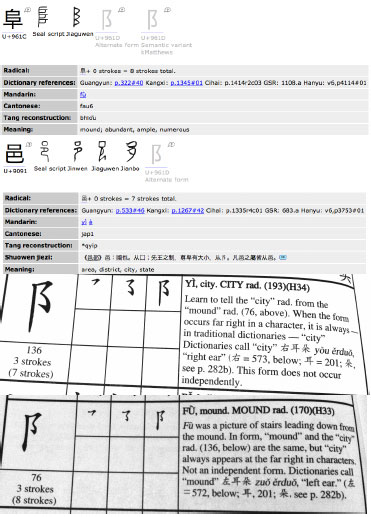
I posted all of these roots in order to understand that “ear” is a euphemism, and this character 那 na4 is more complex than a facial appendage. The right character looks like a “B,”which we now know signifies for breasts, and it means “mound,” “city”( a city is where you would find sex more likely with women than animals). The character at left is aversion of the “moon/flesh” radical. “Those, that” are the way people refer to animals or things that are important to refer to, but not important enough to have a name, and I suspect that this term grew out of the importance of animals that produce milk.
那儿 = that/there (takes “ge”)
na4 er2
compare with:
哪儿
na3 er2 = where?
Note different tone, additional character on left
哪儿
na3 er 2 = which, where, how
(sounds like “nar)
這/这 = this; these
zhe4
这儿
zhe4 er2 = this here (takes “ge”)
(sounds like “jar”)
在 = at; in; exist; (before verbs) immediately involved in; right in the middle of doing
zai4
你在哪儿? = where are you?
ni3 zai4 na3 er2
我在哪儿 = here I am
wo3 zai4 na3 er2
哪是谁?
Who is that? (literally “Which is who?”)
na3 shi4 shei2or
他是谁?
Who is that? (literally “He is who?”)
ta1 shi4 shei2
那是谁 = That is [name]
na4 shi4 shei2 [name here]
國/国 = country, state, nation
guo2
王 = king
wang2
玉 = jade
yu4
Only the king has jade, and once he has enough jade, he can power a country (note that country has king/jade inside a boundary. It used to have a weapon).
wang2 ba1 = tortoise (see beginning of class notes)
“On the ‘Double nine holiday’ Chinese go high to the top of the mountain to burn incense; also burn in house, kill insects. Children have a letter written on forehead (saying that they are not children?) so that bad evil cannot get to kids.” Anyone else get a better version of this?
蛋 = egg, oval-shaped
dan4
中 = within; among; in; middle; center; while (doing sth); during; China; Chinese
zhong1 (my note: China is the center)
中国 = China (the People’s Republic of China; the center country)
zhong1 guo2
美 = beautiful (literally “big sheep”)
mei3
美国 = U.S.A. (country)
mei3 guo2
中国人 = Chinese person
zhong1 guo ren2
美国人 = American
英国人 = English person
ying1 guo ren
(Note: our teacher mixes “yin” and “ying” consistently. Please keep this in mind.)
英 = English; brave
文 = language; culture; writing; formal; literary; gentle
wen2
中文 = Chinese language
zhong1 wen2
問/问 = ask (Which gates do you think a person is asking to open?)
wen4
问我 = ask me
wen4 wo3
語/语 = dialect, language, speak
yu3
吻 = kiss, mouth
wen3
吻我 = kiss me
Note the relationship between:
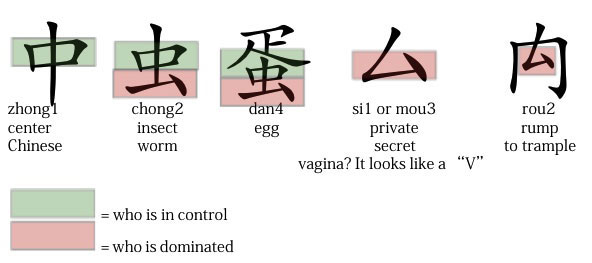
Next class: countries, occupations.
Ms. Lin comments:
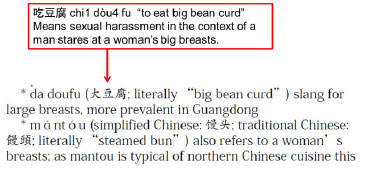
“Sandhi (Sanskrit: saṃdhi[1] “joining”) is a cover term for a wide variety of phonological processes that
occur at morpheme or word boundaries (thus belonging to what is called morphophonology). Examples include the fusion of sounds across word boundaries and the alteration of sounds due to neighboring sounds or due to the grammatical function of adjacent words. Sandhi occurs particularly prominently in the phonology of Indian languages (especially Sanskrit, which has complex sandhi rules), hence its name, but many other languages have it.” — Wikipedia

http://en.wikipedia.org/wiki/Mandarin_Chinese_profanity
Chinese characters and definitions from:
http://ctext.org/dictionary
http://www.mandarintools.com/
http://www.google.translate
http://www.cantonese.sheik.co.uk/dictionary/words/8586/
